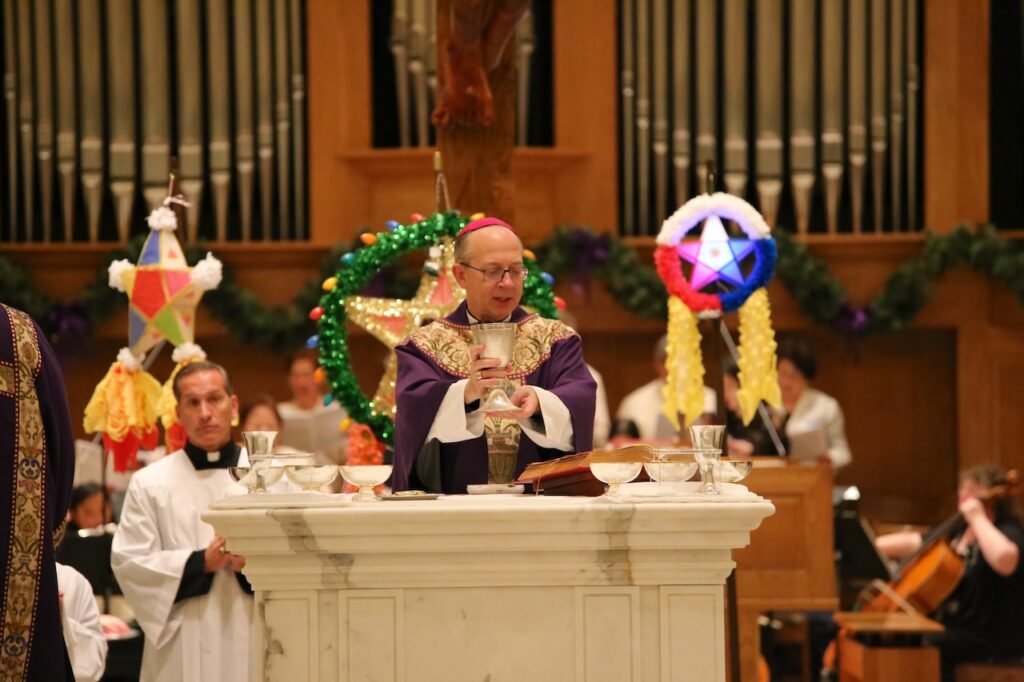The Philippines is no winter wonderland. In recorded history – even in the mountainous regions – residents have never seen so much as a snowflake. Instead, December is the middle of planting season, and farmers start early in the morning to avoid sweating in the midday heat.
During Spanish rule over the Philippines, a unique tradition grew around the farmers’ schedules. Beginning in 1669, priests held Mass before sunrise – as early as 3 a.m. – on the nine days before Christmas, mirroring the evening novenas held in other parts of the Spanish world. Centuries later, the early morning novena known as Simbang Gabi is an ingrained element of Filipino culture.
Before electricity, the faithful would light their way with paróls, colorful star-shaped lanterns. Today, these lanterns are still an iconic feature of Filipino Christmas decorations. Unlike other Masses held during Advent, the priests’ vestments during Simbang Gabi are white and the Gloria is sung.
“In the nine days leading up to Christmas, [Simbang Gabi] provides that extra focus and attention leading up to the birth of Jesus, carving out time in those immediate days to hold vigil for those days of preparation,” said Craig Ramiro, a leader in the Fil-Am (Filipino American) Ministry at St. Bede, Williamsburg.
“The nine-day novena is the gift of the faithful to the Lord at his birth,” said Father Joker Bayta, pastor of St. Richard, Emporia, and a native of the Philippines. “The mood is festive. It’s a votive Mass; it does not correspond to the liturgical calendar. The prayers are not strictly those of the Advent season, but in honor of the Blessed Virgin Mary.”
In the Richmond diocese, Simbang Gabi is celebrated by the Filipino community each year. This year, in addition to the opening Mass at St. Bede on Dec. 9, 21 parishes are holding 39 Masses for Simbang Gabi from Dec. 15-23, with at least three a day held across the diocese.
“The novena in the Philippines runs from Dec. 16-24,” explained Luz Rayel-Straub, representative for the Filipino communities in the diocesan Ethnic Ministries Advisory Committee. “The diocese allows us to do it one day earlier, at nighttime, from 4 p.m. onward. They are considered vigil Masses.”
“In the evening, more people can attend,” she added. “It’s also appropriate because, in the Philippines, the next day has already begun.”
Rayel-Straub helps to coordinate scheduling in the diocese. Some neighboring parishes coordinate so that parishioners can attend different churches and complete the full nine-day novena.
This year, the opening Mass at St. Bede was celebrated on Saturday, Dec. 9, the vigil of the second Sunday of Advent. Bishop Barry C. Knestout was the celebrant, concelebrating with St. Bede pastor Father Eric Ayers, and assisted by Deacon Lito Magsombol of St. Luke, Virginia Beach. Because it was a few days before Simbang Gabi began, it wasn’t part of the novena, but it was a chance to showcase Filipino traditions.
“[St. Bede music director] Aaron Renninger took the lead for the Mass, knowing we would have regular Sunday parishioners. [My wife] Rochelle and I worked with him to select the songs in a foreign language,” said Ramiro. “From the get-go, he said that he wanted to have as much Tagalog in the liturgy as possible.”

Tagalog, the national language of the Philippines, was used for the second reading and the proclamation of the Gospel. Meanwhile, cantor Jennifer Pohren led the choir in traditional Filipino hymns, including verses in Tagalog and English.
“The style [of the hymns] is an old Filipino style. It’s got a Spanish influence,” said Pohren. “It’s got a dance-like quality.”
Spanish speakers may have noticed several cognates in the Filipino hymns. The Agnus Dei was sung in Tagalog; “Kordero ng Diyos,” or “Lamb of God,” corresponds to the Spanish “Cordero de Dios.”
“The Philipines was colonized by the Spanish,” explained Pohren. “They weren’t allowed to speak Spanish because it was the language of the ruling class, but they adopted many of their words.”
The version sung at St. Bede was “a very famous version of the Agnus Dei,” said Rayel-Straub, explaining that those who grew up in the Philippines would have recognized it from attending Mass when they were younger.
The choir performed on the strength of just two practices, but, as Pohren explained, “The older folks know these tunes.”
Having grown up in the United States, Pohren does not speak Tagalog, but says she has a “working knowledge” of the language from growing up around it. “The older folks help with my pronunciation,” she said.
In his homily, Bishop Knestout touched on the way in which Simbang Gabi demonstrates a fusion of daily life with contemplative preparation.

“Simbang Gabi is an Advent celebration which recognizes our need to weave seamlessly our Advent spiritual preparation with the routine of life – planting and harvesting, through wet seasons and dry seasons, in good times and bad, times of difficulty and ease,” said the bishop. “This is a beautiful Advent tradition that helps us be ready for the coming of the Lord.”
Last year, the kick-off Mass was held at Holy Cross, Lynchburg; next year, Rayel-Straub says plans are forming to hold it in the newly-minted Basilica of St. Andrew, Roanoke.
“It’s good to combine the Simbang Gabi tradition with a Sunday Mass so that it’s shared with other Americans,” she said.
“I grew up in the Diocese of Richmond – my home parish was St. Gregory the Great, Virginia Beach. I don’t ever remember attending Simbang Gabi as a kid – but my wife and her family did,” said Ramiro. “When we ended up settling here in Williamsburg at St. Bede and started having our own family, it was important to keep that tradition alive.”
See the schedule for Simbang Gabi celebrations across the diocese.

